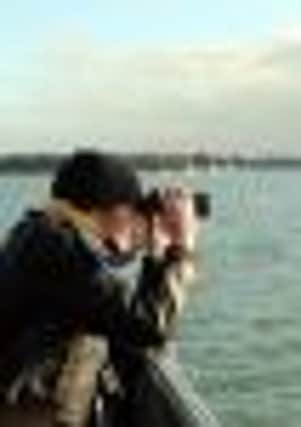Chichester Harbour is perfect for winter birdwatching


While such animals have long since vanished from our shores as our terrain and climate has shifted radically down the ages, the area still attracts some real wildlife treasures.
Not least of these is the wealth of birdlife from across the world making a beeline for what continues to be an internationally-renowned haven for some intriguing feathered friends.
Advertisement
Hide AdAdvertisement
Hide AdAmong its many visiting stars are the migratory Brent geese, which have made the arduous journey thousands of miles from northern Russia to winter here.
Incredibly, more than ten per cent of the entire global population descend on the area from around December until spring when they make the epic return leg.
Catching sight of hundreds of them taking flight across the harbour is quite some sight and it has our boatful of 30 birdwatchers eagerly craning over the sides for the best views.
Shortly after the geese take flight we encounter a peregrine falcon which calmly eyes up our unique Solar Heritage vessel from the harbour banks. It quickly has our measure and decides it has far more interesting matters on its mind in scouring the skies for potential prey.
Advertisement
Hide AdAdvertisement
Hide AdNext up we encounter a large cormorant perching atop a channel marker, carefully spreading its dark wings to their fullest extent.
As our guide for the morning, countryside ranger Pete Potts explains: “This is one bird that’s failing to keep up with evolution,” as unlike most species its feathers don’t have any water-resistant oils.
This means it is perpetually having to sunbathe to dry itself out which is just fine during the summer – but in the height of January it’s perhaps not so much fun.
Then at the other end of the scale there’s the dainty dunlin waders which hug the shoreline in dense flocks. Clearly there’s safety in numbers – especially with a peregrine on the prowl.
Advertisement
Hide AdAdvertisement
Hide AdSuch sights are just some of many which harbour conservation officer Ed Rowsell continues to savour through keeping a watchful eye on the ever-evolving lists of inhabitants.
Even after five years in the role he says there’s always something new to appreciate and he enjoys passing on knowledge to the many thousands of visitors a year.
“The harbour is such an important place for birdlife – it’s internationally significant for several species of birds including the Brent geese, dunlin and black-tailed godwit.
“I think what makes it special is the fact it’s such a varied habitat with large expanses of mud flats and quite an undeveloped coastline which means the birds can move from arable fields to the shore. It’s just such a nice place.
Advertisement
Hide AdAdvertisement
Hide Ad“The Solar Heritage is a great way to see the harbour for birdwatching as it’s totally silent so it doesn’t disturb the birds and there’s no pollution from it.
“The stability of the boat offers a great viewing platform and we find people even bring telescopes on board,” adds the officer of our highly-unusual transport.
Sadly we miss out on seeing some of the harbour’s other stars – its seal population which are often to be found around Thorney Island, but it seems they are still very much thriving in the area.
“I love my work here because of the varied nature of it. Seeing the seals is a highlight and we believe there are 22 of them in the Solent,” says Ed.
Advertisement
Hide AdAdvertisement
Hide Ad“I can remember when we put GPS tags on them back in 2007 which lasted about six months.
“There are often new things that are discovered here such as rare snails and I’ll often be busy on work including fish surveys and working closely with our education officers,” Ed says of his role, which he believes is helping make a difference to ensuring the survival of this impressive marine environment.
- Winter birdwatching tours in Chichester harbour run until March.